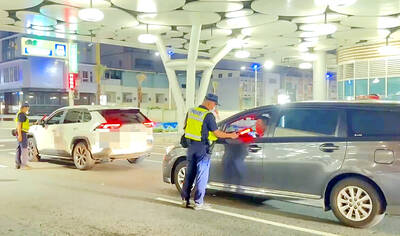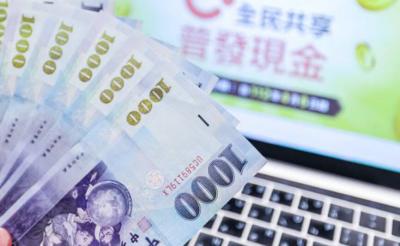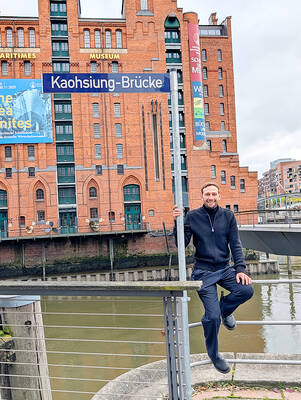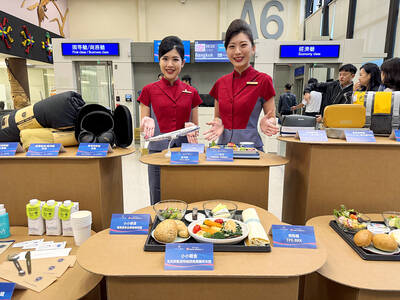Blue light emissions from electronic products can easily harm children’s eyes and cause cataracts, ophthalmologists warned parents, as an increasing number of children are being taken to hospitals and clinics with eye problems.
Changhua County Show Chwan Healthcare System vice superintendent Lin Hung-yu (林浤裕) said there was a recent case in which a kindergarten-aged child had played on his mother’s cellphone every day for several months. After noticing the child squinting at everything, the parents took him to the clinic.
The child had initially been diagnosed with high myopia, a condition which doctors later ruled out because it is congenital and both parents had mild myopia, Lin said.
After further questioning, the parents revealed that both had been busy at work and often worked from home as well.
“This lifestyle left them little time to spend with their children, and whenever the child started crying for attention, the parents gave him the cellphone to play on, as it usually quietened him down,” Lin said.
The situation had devolved to the situation where the child became addicted to the phone and wanted to play on it even when the parents were not busy, Lin said, adding that the boy usually spent more than half an hour a day on the cellphone.
Due to the lengthy periods the boy spent staring closely at the screen, his ciliary muscles had lost the capability to adjust to things in the distance. He was later diagnosed with pseudomyopia, Lin said.
Lin said that after three months of treatment using a ciliary muscle relaxant, the boy was in the low myopia range.
Myopia, or simple myopia, is a condition in which sight begins to blur when looking at things in the distance, and it can be improved with corrective lenses.
Pseudomyopia is a condition in which spasms of the ciliary muscles cause the person to develop symptoms similar to simple myopia, but which can be treated by relaxing the ciliary muscle through methods such as relaxants.
Lin said more than 30 percent of children who have come to the clinic with eye problems had been playing on their mothers’ cellphones.
He added that if parents did not curb the tendency, the children could go develop high myopia.
Tri-Service General Hospital head of ophthalmology Lu Ta-wen (呂大文) said rates of children with pseudomyopia tended to peak after the winter and summer vacations.
During this period, the children spent more time at home and often spend too much time using electronic devices, Lu said.
“Blue light emitted by electronic products can easily cause cataracts to form and may also harm the macula lutea,” Lu said.
He said that it was best not to let children under the age of six use any electronic products.
“The vision of children who develop myopia tends to deteriorate quickly, and they should not be allowed to use smartphones for more than 40 or 50 minutes without taking a break for at least 10 minutes,” Lu said.
Lu also suggested parents be careful when treating myopia in children, as it may sometimes be pseudomyopia and was not true nearsightedness.
Parents should let an ophthalmologist examine their children before taking them to get glasses, he added.
Lu also suggested frequent outings or spending lots of time outdoors, looking at things far away and trying to relax the ciliary muscles to avoid worsening myopia, adding that vegetables and fruits, which are good for the eyes, should be a regular part of children’s diet.

TRAFFIC SAFETY RULES: A positive result in a drug test would result in a two-year license suspension for the driver and vehicle, and a fine of up to NT$180,000 The Ministry of Transportation and Communications is to authorize police to conduct roadside saliva tests by the end of the year to deter people from driving while under the influence of narcotics, it said yesterday. The ministry last month unveiled a draft of amended regulations governing traffic safety rules and penalties, which included provisions empowering police to conduct mandatory saliva tests on drivers. While currently rules authorize police to use oral fluid testing kits for signs of drug use, they do not establish penalties for noncompliance or operating procedures for officers to follow, the ministry said. The proposed changes to the regulations require

The Executive Yuan yesterday announced that registration for a one-time universal NT$10,000 cash handout to help people in Taiwan survive US tariffs and inflation would start on Nov. 5, with payouts available as early as Nov. 12. Who is eligible for the handout? Registered Taiwanese nationals are eligible, including those born in Taiwan before April 30 next year with a birth certificate. Non-registered nationals with residence permits, foreign permanent residents and foreign spouses of Taiwanese citizens with residence permits also qualify for the handouts. For people who meet the eligibility requirements, but passed away between yesterday and April 30 next year, surviving family members

The German city of Hamburg on Oct. 14 named a bridge “Kaohsiung-Brucke” after the Taiwanese city of Kaohsiung. The footbridge, formerly known as F566, is to the east of the Speicherstadt, the world’s largest warehouse district, and connects the Dar-es-Salaam-Platz to the Brooktorpromenade near the Port of Hamburg on the Elbe River. Timo Fischer, a Free Democratic Party member of the Hamburg-Mitte District Assembly, in May last year proposed the name change with support from members of the Social Democratic Party and the Christian Democratic Union. Kaohsiung and Hamburg in 1999 inked a sister city agreement, but despite more than a quarter-century of

China Airlines Ltd (CAL) yesterday morning joined SkyTeam’s Aviation Challenge for the fourth time, operating a demonstration flight for “net zero carbon emissions” from Taiwan Taoyuan International Airport to Bangkok. The flight used sustainable aviation fuel (SAF) at a ratio of up to 40 percent, the highest proportion CAL has achieved to date, the nation’s largest carrier said. Since April, SAF has become available to Taiwanese international carriers at Taipei International Airport (Songshan airport), Kaohsiung International Airport and Taoyuan airport. In previous challenges, CAL operated “net zero carbon emission flights” to Singapore and Japan. At a ceremony at Taoyuan airport, China Airlines chief sustainability